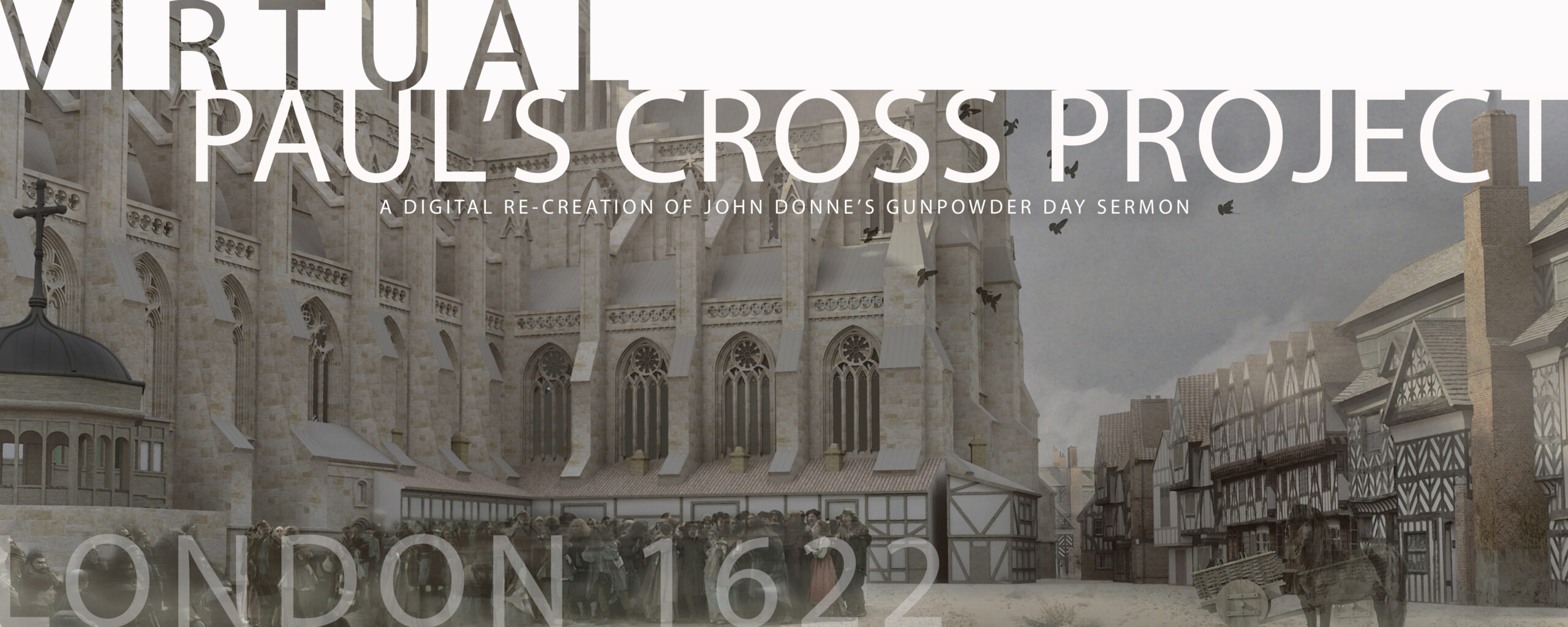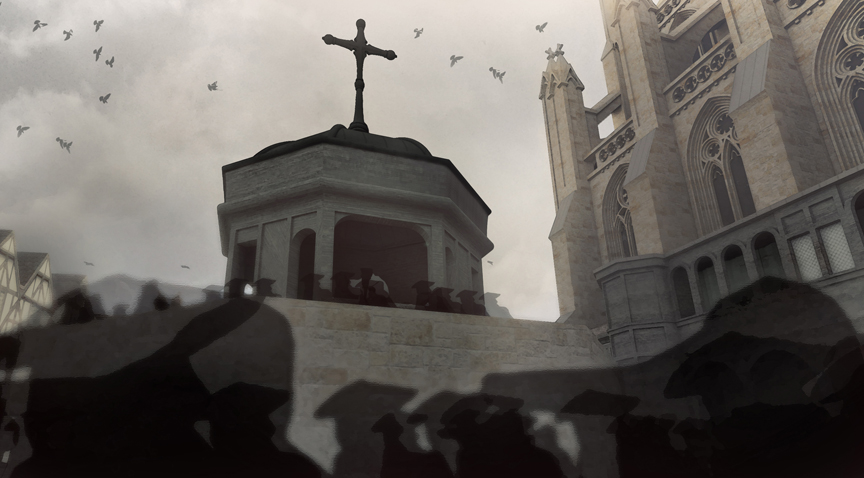Figure 1: Paul’s Cross, from 25 feet. From the Visual Model, constructed by Joshua Stephens, rendered by Jordan Gray.
THE INTERACTIVE SERMON
Modern sermons delivered in the medieval cathedrals and parish churches that are still in use in today’s Church of England are sedate affairs, best compared to academic lectures given to quiet, passive, attentive congregations.
Evidence from contemporary accounts suggest that their early modern counterparts were more like theatrical performances, interactive conversations between preacher and congregation, events staged for their entertainment value as well as for their potential to edify and educate, rituals of social collaboration choreographed by the preacher but in which both preacher and congregation had active roles to play.
Evidence for thinking of the early modern sermon as an interactive performance in which the congregation and preacher collaborated in the creation of the occasion comes from contemporary accounts such as Donne’s comments on his congregation in a sermon preached at St. Paul’s, on 2 Corinthians 5. 20. (Donne, Sermons X. 132-34)
Donne claims that he is describing the behavior of ancient congregations when he says that that “all that had been formerly used in Theaters, Acclamations and Plaudites, was brought into the Church, and not onely the vulgar people, but learned hearers were as loud, and as profuse in those declarations, those vocall acclamations, and those plaudites in the passages, and transitions, in Sermons, as ever they had been at the Stage.”
Indeed, Donne says, “if you do not joyne with the Congregation in those Plaudites, the whole Congregation will thinke you the onely ignorant person, in the Congregation.”
He then brings his accounts closer in time, noting that “this fashion continued in the Church” and “is yet left in some places . . . where the people doe yet answer the Preacher, if his questions be applyable to them, and may induce an answer, with these vocall acclamations, Sir, we will, Sir, we will not.”
Finally, he infolds his description of a congregation’s intermixing of its response to preaching and to theater into the present moment and the present congregation: “Truely wee come too neare re-inducing this [behavior] in those often periodicall murmurings, and noises, which you make, when the Preacher concludeth any point; for those impertenent Interjections swallow up one quarter of his houre, and many that were not within distance of hearing the Sermon, will give a censure upon it, according to the frequencie, or paucitie of these acclamations.”
This description by Donne gives us two important bits of information. One is confirmed by the Audibility section of this website, which demonstrates that people at the edges of crowds of a thousand or more in Paul’s Churchyard had more difficulty hearing much of the sermon being delivered than those standing or sitting closer.
The other is that congregations had an active role in creating what actually went on during an early modern sermon, with the distractions to listening and the opportunities for joining in the discourse magnified by the outdoor setting of these sermons.
We know that these sermons were not written out in advance but were prepared for through the assembly of notes from which the actual sermon was composed and performed on the fly, open to expansion or contraction, to improvisation in response to the congregation’s behavior, and to the ongoing unfolding of the time of performance in relationship to markers such as the passage of sand in an hourglass or, in the case of Paul’s Cross, a clock chiming the hour and the quarter hour.
The challenge we have in envisioning a sermon as a conversation, as an interactive event, rather than a lecture, is of course compounded by the fact that texts of sermons that come down to us have been restored to us as lectures, as theological essays, missing the congregation’s side of the conversation.
Part of the challenge of interpreting Paul’s Cross sermons is, therefore, to find ways of hearing traces of the lost other side of the conversation, both in the texts as we have them and in a reading of those texts informed by our understanding of the dynamics and distractions of the occasion.
The rest of this section will offer excerpts from the site’s recreation of Donne’s Paul’s Cross sermon for November 5th, 1622 which may offer us clues as to how, or when, the congregation interacted with Donne in the course of his sermon, as well as how, and when, Donne’ may have choreographed their response by the tone or content of his sermon.
Scripted Interaction
One kind of congregational response to Donne’s sermon is the scripted interaction, the responses that are called for from the congregation by an occasion and among a congregation familiar with the structured and scripted worship of the Church of England made possible by the Book of Common Prayer.
Sixty years after the Elizabethan Settlement of Religion and sixty years into what Eamon Duffey has described the process by which England internalized Cranmer’s liturgical language, Donne’s congregation would have responded automatically to hearing “The Lord be with you” with “And with thy Spirit.” They would have known the Lord’s Prayer by heart.
But even if they were not thinking about Morning Prayer while sitting or standing in Paul’s Churchyard on a chilly, cloudy November morning, Donne reminded them of it with the language of his opening prayer, saturated as it is with echoes of the Prayer Book’s Canticles and Responses.
“O Lord open thou our lips, and my mouth shall shew forth thy praise,” Donne says, “For thou, O Lord, didst make haste to help us . . . in these houres, We praise thee, O God, we knowledge thee, to bee the Lord; All our Earth doth worship thee; The holy Church throughout all this Land, doth knowledge thee, with commemorations of that great mercy, now in these houres.”
In the context of these echoes of the Versicles and Responses and the Te Deum from Matins , here are three examples from the sermon that we might call scripted interactions.
The first is the “Call to Attention” interchange at the beginning of the event.
The second is the unison recitation of the Lord’s Prayer at the end of the Opening Prayer.
The third is the congregational “Amen” at the end of the sermon, not a part of the historic script but a reasonable inference from the tradition of such responses.
Organizational Passages
Arnold Hunt has reminded us that one way members of Donne’s congregations participated in his sermons was by taking notes. Tiffany Stern has noted that by taking notes, sermon-hearers were not only engaging in educational activities but were also performing the role of attentive sermon-goer and serious Christian person.
Here are four short moments in which Donne guided his congregation through the instructional content of his sermon.
Instructional Sections
Here are three short moments in which Donne is providing instructional content for his sermon.
Expository Sections
Here are three short moments in which Donne is developing his arguments.
Witty Interchanges
Here are three short moments in which Donne seeks to engage his congregation through making witty asides or wry comments or finding humor in a potentially tense situation.
Emotionally Evocative Passages
Here are three excerpts from larger passages when Donne seeks to rouse his audience by connecting with them emotionally. Here, the simulation has the audience’s noise level rise in response to the preacher’s emotional intensity.
The Bell
Donne knew that the bell in the cathedral clock would ring on the quarter hour as well as the hour. This bell is reported to have been audible over a large area of London, hence it is unlikely that Donne would have tried to talk over it, but instead paused in his delivery rather than compete with it for his audience’s attention.
That is the assumption that governs the way the bells are treated in these files.
Therefore, given Donne’s known ability to time his sermon composition in the pulpit to fit the passage of time as marked by the movement of sand through an hourglass, it seems worth considering whether he was able to time the breaks in his delivery to fit into the development of his argument.
When looking for moments to insert the bells, we noticed that 15-minute intervals often seemed to fall close to moments that called for a break, or a transition, or a pause for emphasis. By the time we noticed this, the sermon recording was done.
This recording was done with primary regard for maximum audibility, hence the deliberate pace of the sermon (see the discussion of the style of delivery on the Sermon page).
We were also aware that the text of the sermon we were using was created after the fact of delivery, when questions of timing for delivery were in the past and hence no longer relevant.
We decided to test the hypothesis that the actual sermon as delivered would have been paced to take advantage of the breaks created by the bell tolling every quarter hour. So we bent time to fit the sermon, rather than bending the sermon to fit the time. Each performed quarter of an hour is slightly shorter or longer than 15 actual minutes by a minute or so; the resulting congruence between the rhetorical structure of the sermon and the tolling of the bells is remarkable.
Here are three excerpts in which the tolling of the clock bell seems to signal a break, or reinforce a point in the argument, or signal a transition in the argument of the sermon.

